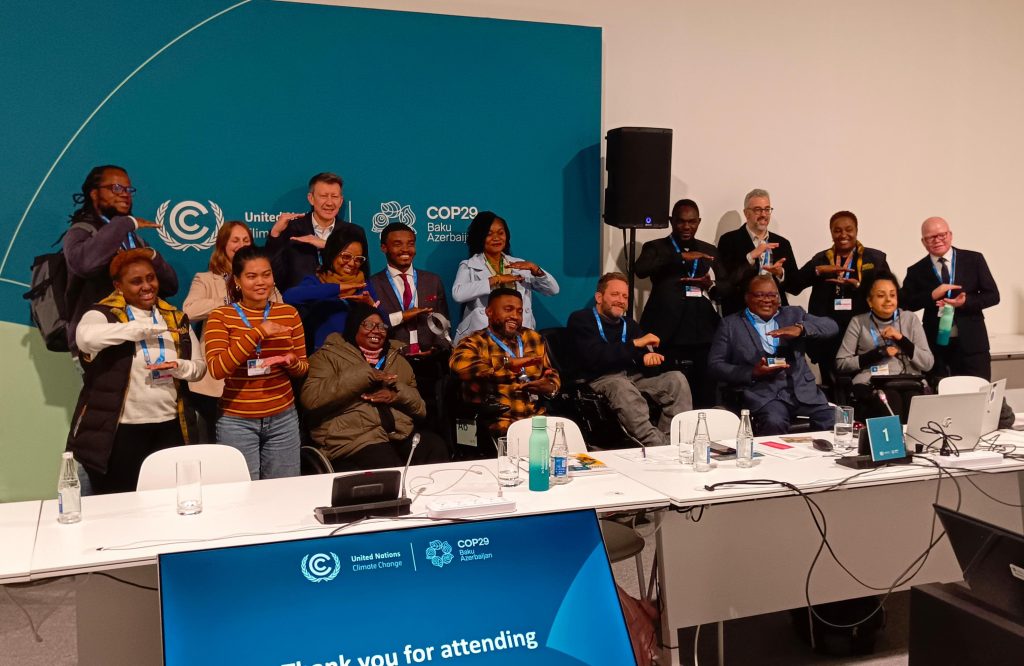Breaking Barriers at COP29 & Beyond
By Jorge Manhique, Senior Program Officer

In November 2024, I joined fellow disability rights activists in Baku, Azerbaijan, to attend the United Nations Climate Change Conference, commonly known as COP. DRF’s goal at COP29 was to highlight the urgent need to invest in the intersection of disability and climate change and advocate for increased funding.
Alongside our allies, we worked towards two key objectives:
- Recognition of persons with disabilities as a formal constituency within COP.
- Meaningful influence in negotiations to ensure disability inclusion in climate action.
Why Constituency Recognition Matters
The recognition of persons with disabilities as a formal constituency within COP is crucial as it determines the movement’s ability to influence negotiations.
“The formal recognition of disability within COP will ensure that OPDs representing 1.3 billion people worldwide (1 in 6 people) can participate in climate negotiations on an equal basis with others.”
Nadia Hadad on behalf of the Disability Caucus
During a meeting with the Disability Caucus, the United Nations Framework Convention on Climate Change (UNFCCC) Secretariat committed to prioritizing this recognition. This is significant given that the European Disability Forum and the International Disability Alliance applied for constituency status over two years ago and have yet to receive a response.
Despite the lack of formal recognition, the UNFCCC provided support for the Disability Caucus throughout COP29. This included allocating meeting spaces and securing speaking slots in plenary sessions. However, accessibility remains a major challenge. Many areas at COP29 were physically inaccessible, and some sessions—including plenaries—lacked sign language interpretation and captioning.
Influence on Negotiations: Progress and Challenges
Reactions to COP29 negotiations were mixed. Some stakeholders noted a rollback on previously agreed language concerning gender and intersectionality. Additionally, space for dissenting voices was limited, with demonstrations restricted to designated areas.
Nevertheless, the persistent advocacy of organizations of persons with disabilities (OPDs) and their allies led to the inclusion of disability references in the following key COP29 outcome documents:
- New Collective Quantified Goal on Climate Finance (NCQG): Three references to disability.
- Global Goal on Adaptation (GGA): Two references to persons with disabilities in indicators measuring social inclusion.
- UAE Just Transition Work Program: Two references to persons with disabilities.
These modest yet significant gains were possible due to the solidarity of other constituencies—such as the Women and Gender Constituency and the Indigenous Peoples’ Constituency—who advocated for disability inclusion in spaces where OPDs were not present.
DRF’s Next Steps: Strengthening Disability Inclusion at COP
COP29 was also significant for DRF because our application for observer status was approved. This means we can better support OPDs and our grantees in climate justice advocacy.
Moving forward, DRF will focus on:
- Increasing the presence of persons with disabilities at COP: Greater visibility will help push for comprehensive accessibility and ensure OPDs have a stronger voice.
- Capacity building for OPDs and DRF staff: Navigating COP is complex, and without preparation, it can be overwhelming. OPD leaders need to understand:
- How COP functions.
- How to engage and influence negotiators of state parties.
- Which other mechanisms, such as subsidiary bodies, can be leveraged for advocacy.
3. Collaborating with OPDs and allies to strengthen the Disability Caucus: A well-structured and well-funded caucus—or, ideally, a recognized constituency—will enhance OPDs’ ability to advocate effectively for climate justice.
DRF remains committed to ensuring disability rights are central to climate action. The momentum built at COP29 is a step forward, but much work remains to be done.